Prediction of Peak Overpressure of Charge Enveloped by Polymer Matrix Composite: Theoretical Modeling and Experimental Verification
Abstract
1. Introduction
2. Mechanism of a Charge Enveloped by a Polymer Matrix Composite Shell
- (1)
- The detonation reaction stage of the inner charge. As shown in Figure 2a, the explosive molecules undergo a rapid oxidation-reduction reaction after charge initiation, accompanied by the propagation of the detonation wave in the explosive. The detonation wave interacts with the cladding layer at the interface and causes shock-wave transmission and reflection.
- (2)
- The mixing and expansion stages of the detonation products and cladding. As shown in Figure 2b, the detonation products expand without oxygen after detonation. Simultaneously, the cladding materials undergo considerable deformation during dispersion and absorb the explosion wave energy.
- (3)
- The formation stage of the blast shock wave. As shown in Figure 2c, the mixture of the expanding detonation products and dispersed cladding will rapidly compress the air, leading to shock-wave formation in the air. Thereafter, the propagation speed of the primary shock wave will gradually become greater than the expansion speed of the detonation products, resulting in the shock wave separating from the fireball.
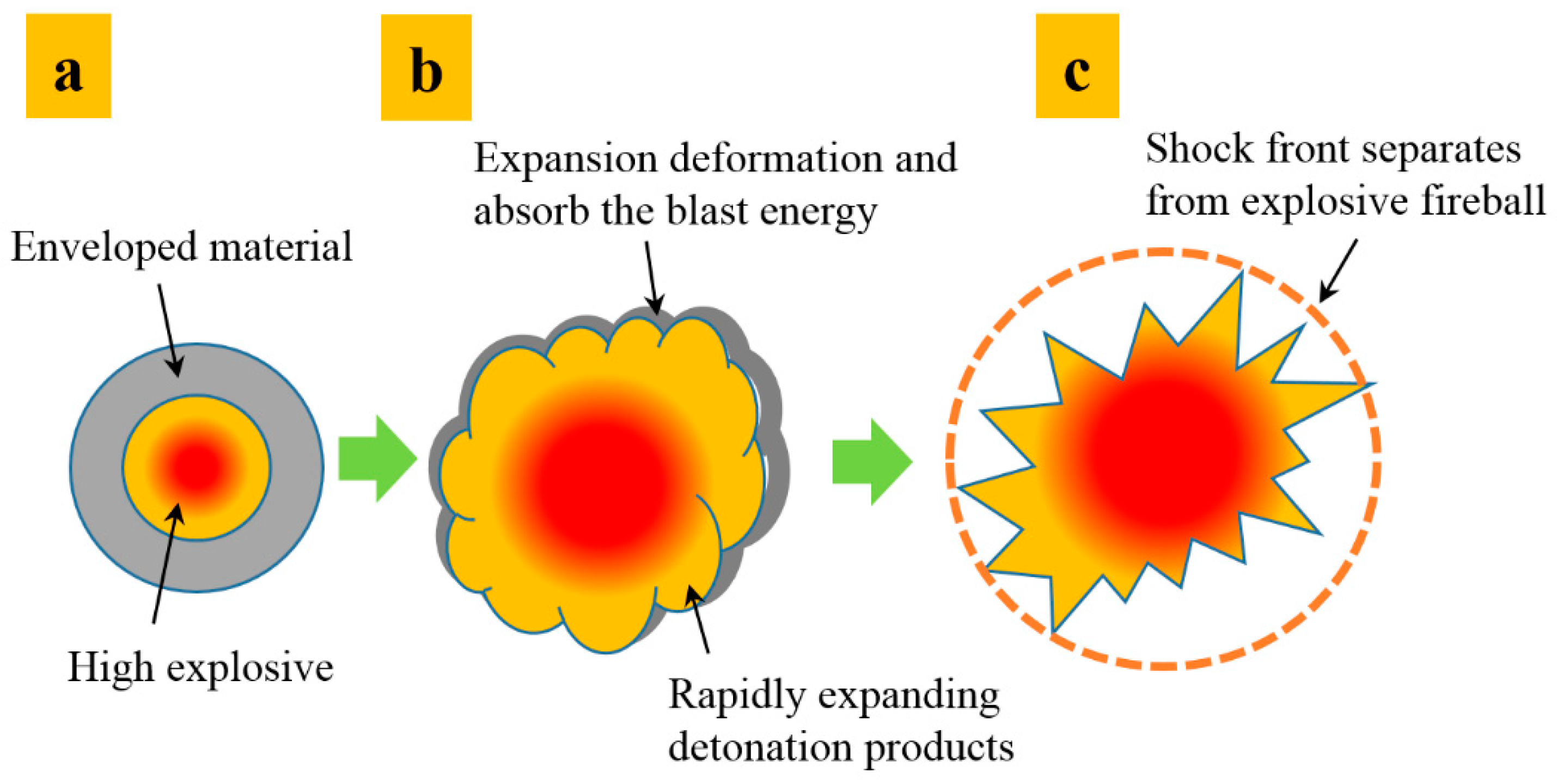
3. Prediction of Peak Overpressure Based on the Initial Parameters of the Blast Wave
3.1. Initial Blast Shock Wave Parameters
3.2. Scaling Law of Explosion
4. Prediction of Peak Overpressure Based on the Conservation of Energy Law
4.1. Energy of the Detonation Products
4.2. Energy of the Cladding
5. Experimental Verification
5.1. Experimental Design
5.2. Model Verification
6. Conclusions
Author Contributions
Funding
Institutional Review Board Statement
Data Availability Statement
Conflicts of Interest
References
- Maiz, L.; Trzciński, W.A.; Szala, M.; Paszula, J.M. Studies of confined explosions of composite explosives and layered charges. Cent. Eur. J. Energetic Mater. 2016, 13, 957–977. [Google Scholar] [CrossRef] [PubMed]
- Trzciński, W.A.; Barcz, K.; Paszula, J.; Cudziło, S. Investigation of blast performance and solid residues for layered thermobaric charges. Propellants Explos. Pyrotech. 2014, 39, 40–50. [Google Scholar] [CrossRef]
- Maiz, L.; Trzciński, W.A.; Paszula, J. Semi-closed investigations of new aluminized thermobaric and enhanced blast composites. Propellants Explos. Pyrotech. 2017, 42, 857–863. [Google Scholar] [CrossRef]
- Li, J.; Li, W.; Yu, J.; Xiao, W.; Xu, H.-Y. Blast performance of layered charges enveloped by aluminum powder/rubber composites in confined spaces. Def. Technol. 2022, 18, 583–592. [Google Scholar] [CrossRef]
- Cannin, A. Directed-Energy Weapons. Air Space Power J. 2021, 35, 57–65. [Google Scholar]
- Gilbert, S.; Hassan, A.; Chen, Y.; Vella, A. Low Collateral Damage Kinetic Energy Projectile. U.S. Patent 9,329,008, 3 May 2016. [Google Scholar]
- Tian, Q.; Hu, J.; Wang, X.; Tang, L.; Dong, Q.; Guo, H.; Zhang, S.; Chen, Q.; Wang, J.; Han, X.; et al. Preparation and properties of Mg-doped Li-B alloy anode materials for high specific-capacity thermal batteries. Mater. Lett. 2022, 316, 132038. [Google Scholar] [CrossRef]
- Wang, K.J.; Rong, G.; Yi, W.J. Design and Damage Performance Ability of Supercavitation Projectile with Shaped Charge. Propellants Explos. Pyrotech. 2020, 45, 587–599. [Google Scholar] [CrossRef]
- Li, J.; Li, W.; Wang, X.; Li, W. Shock response and prediction model of equation of state for aluminum powder rubber matrix composites. Mater. Des. 2020, 191, 108632. [Google Scholar] [CrossRef]
- Wang, D.; Qin, X.; Chen, W.; Wang, S. Simulation of the Deformation and Failure Characteristics of a Cylinder Shell under Internal Explosion. Appl. Sci. 2022, 12, 1217. [Google Scholar] [CrossRef]
- Park, S.; Beak, J.; Kim, K.; Park, Y.-J. Study on reduction effect of vibration propagation due to internal explosion using composite materials. Int. J. Concr. Struct. Mater. 2021, 15, 1–20. [Google Scholar] [CrossRef]
- Gregoire, Y. Experimental and Numerical Study of the Explosive Dispersion and Combustion of Metallic Particles; ISAE-ENSMA National School of Mechanics and Aerotechics-Poitiers: Chasseneuil-du-Poitou, France, 2009. [Google Scholar]
- Yang, S.Q.; Sun, C.J.; Qian, L.X.; Wei, J. Experimentation and fragment flight analysis of low-collateral-damage warhead with nonmetal shell. Chin. J. High Press. Phys. 2018, 32, 134–138. [Google Scholar]
- Chen, Y.; Chen, G. Numerical investigation on influence of material type and thickness of shell on shock wave properties of underwater explosion of explosives with shell. Mine Warf. Ship Self-Def. 2016, 24, 72–77. [Google Scholar]
- Liang, B.; Chen, Z.F.; Lu, Y.G.; Yang, S.Q. Investigation of blast effect pf explosive charge with different shell material. J. PLA Univ. Sci. Technol. 2007, 8, 429–433. [Google Scholar]
- Taylor, G. The pressure and impulse of submarine explosion waves on plates. Sci. Pap. GI Taylor 1963, 3, 287–303. [Google Scholar]
- Bach, G.; Lee, J. An analytical solution for blast waves. AIAA J. 1970, 8, 271–275. [Google Scholar] [CrossRef]
- Brode, H.L. Blast wave from a spherical charge. Phys. Fluids 1959, 2, 217–229. [Google Scholar] [CrossRef]
- Sadovskyi, M. Mechanical Action of Air Shock Waves of Explosion, Based on Experimental Data; Izd Akad Nauk SSSR: Moscow, Russia, 1952. [Google Scholar]
- Li, X.Y.; Liang, M.Z.; Wang, M.F.; Lu, G.X.; Lu, F.Y. Experimental and numerical investigations on the dynamic fracture of a cylindrical shell with grooves subjected to internal explosive loading. Propellants Explos. Pyrotech. 2014, 39, 723–732. [Google Scholar] [CrossRef]
- Cullis, I.G.; Dunsmore, P.; Harrison, A.; Lewtas, I.; Townsley, R. Numerical simulation of the natural fragmentation of explosively loaded thick walled cylinders. Def. Technol. 2014, 10, 198–210. [Google Scholar] [CrossRef]
- Huang, Z.X.; Zhu, X.D. Terminal Effect; Science Press: Beijing, China, 2014. [Google Scholar]
- Walters, W.P.; Zukas, J.A. Fundamentals of Shaped Charges; Wiley-Interscience: New York, NY, USA, 1989. [Google Scholar]
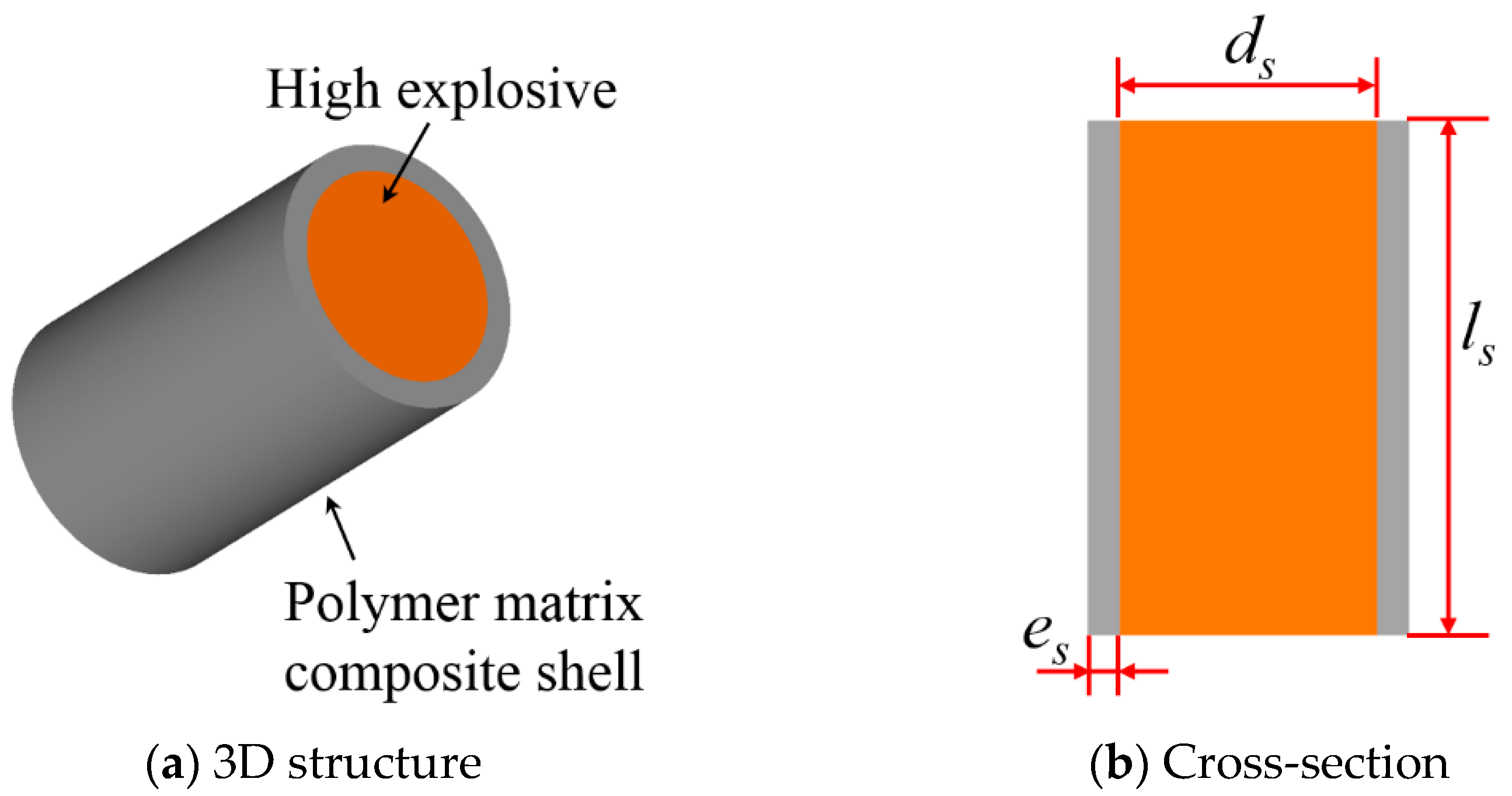
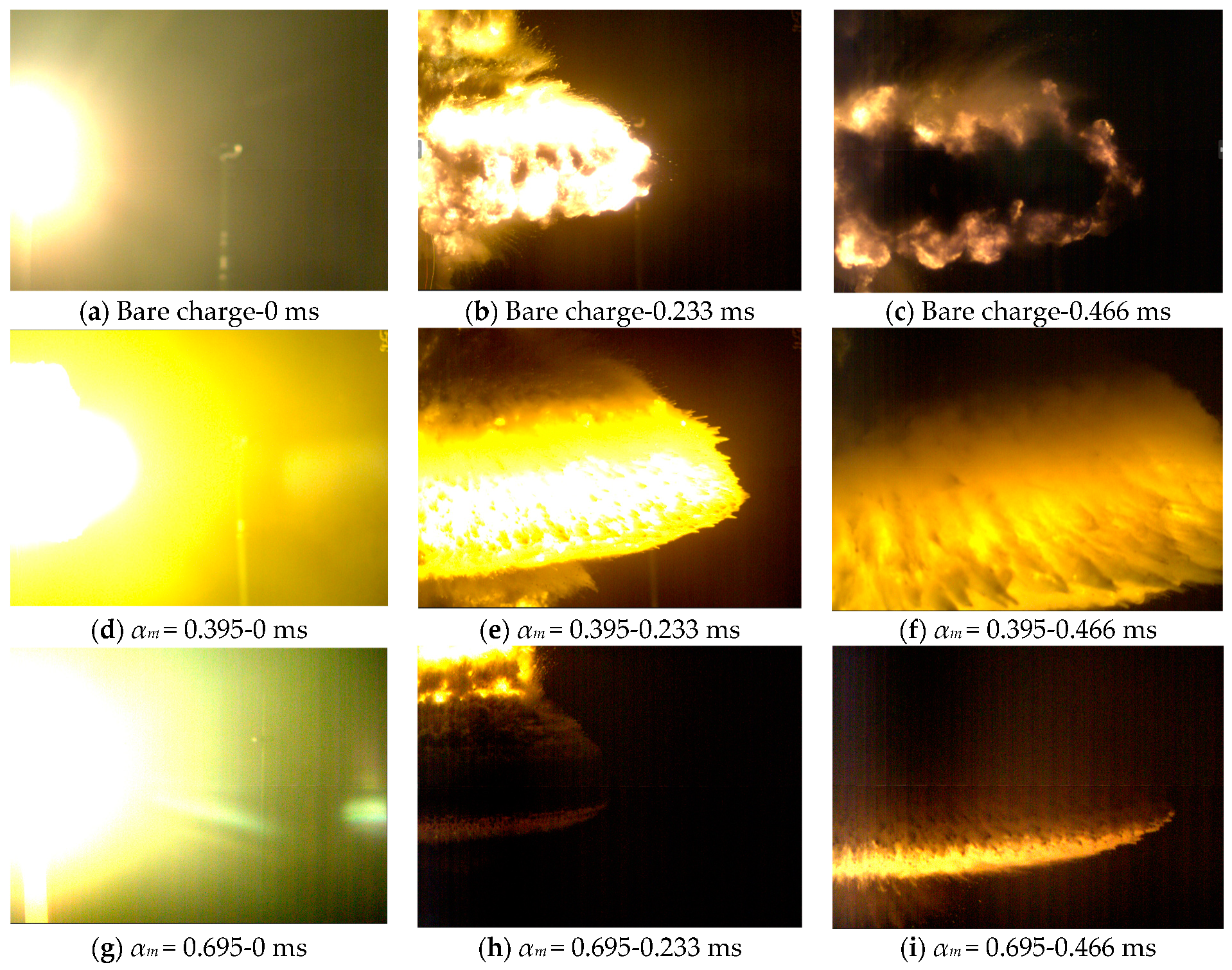


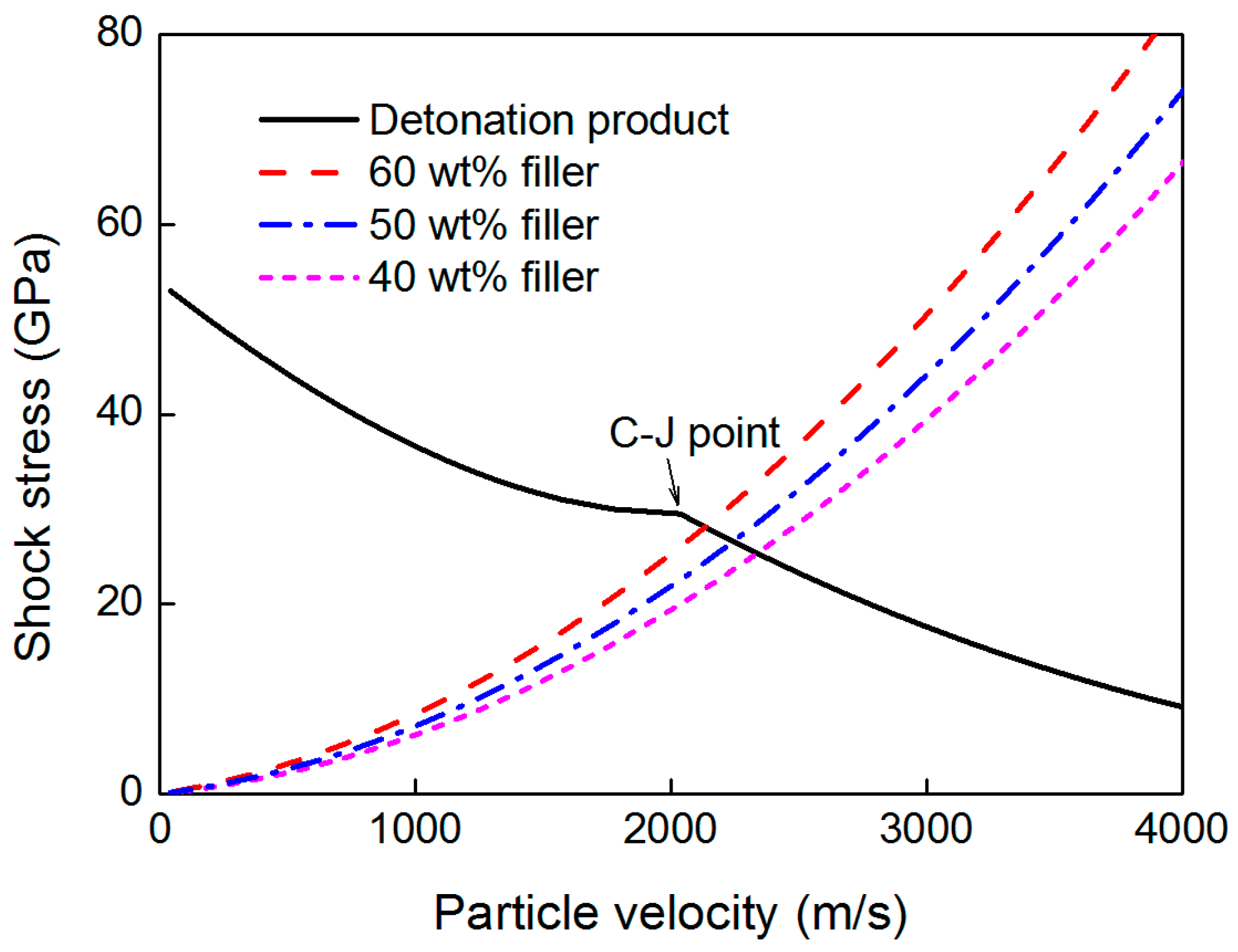
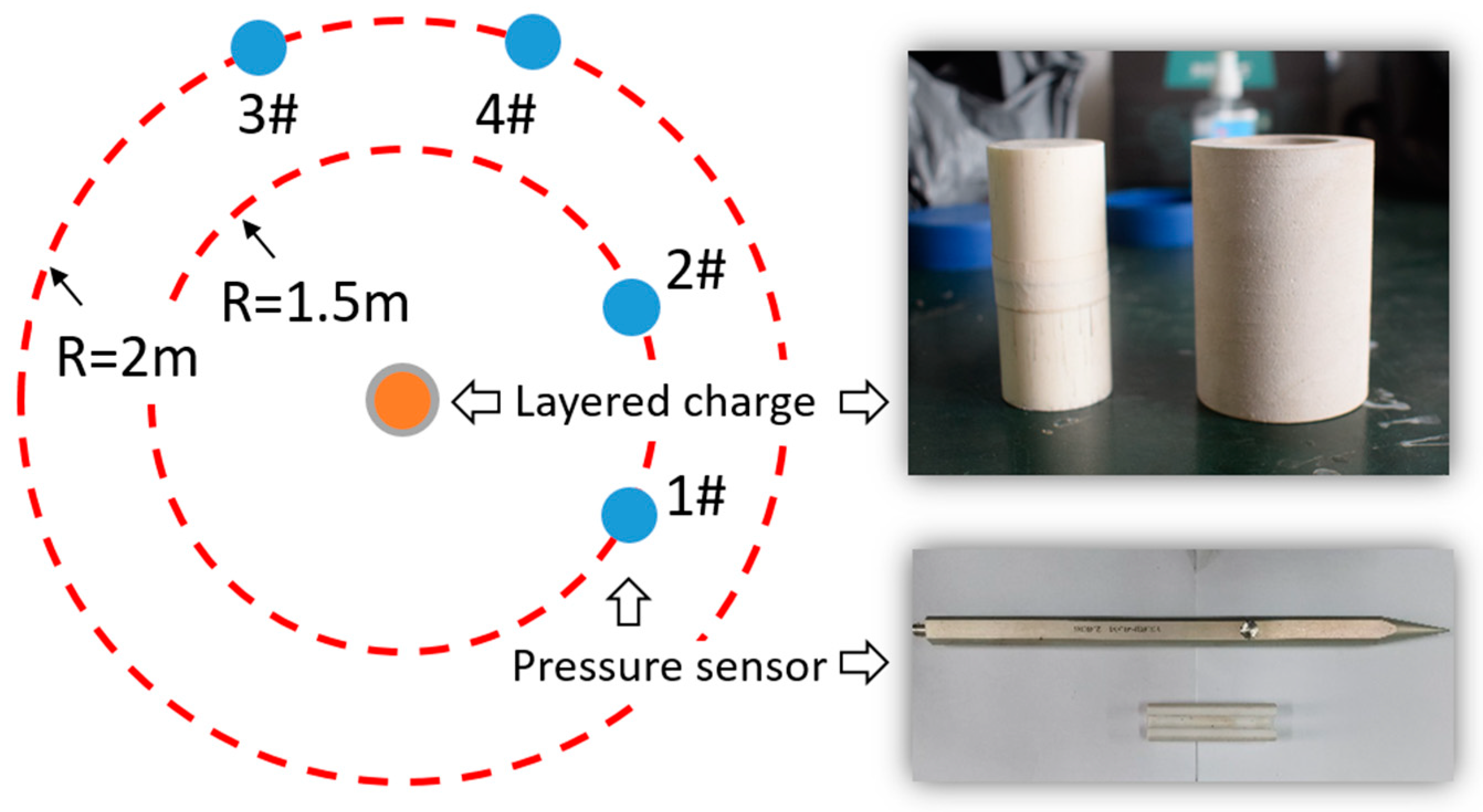
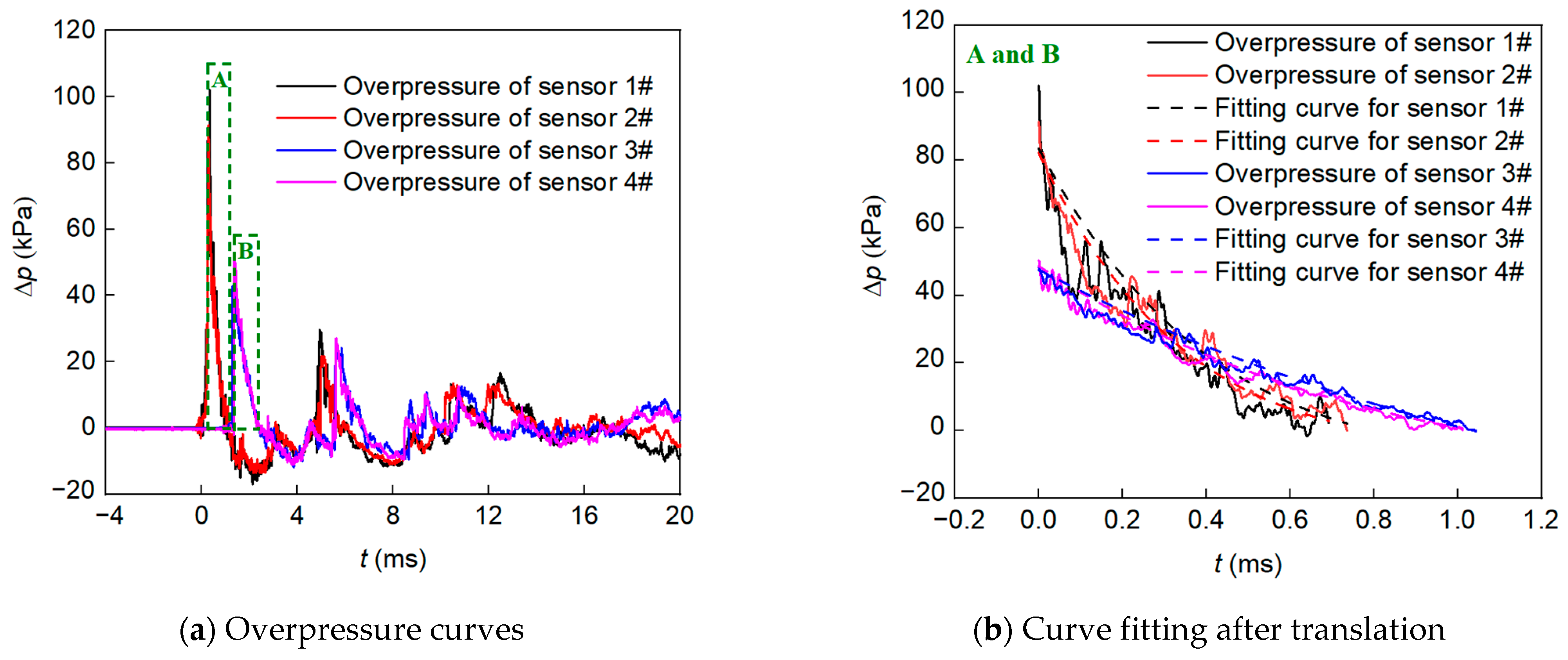
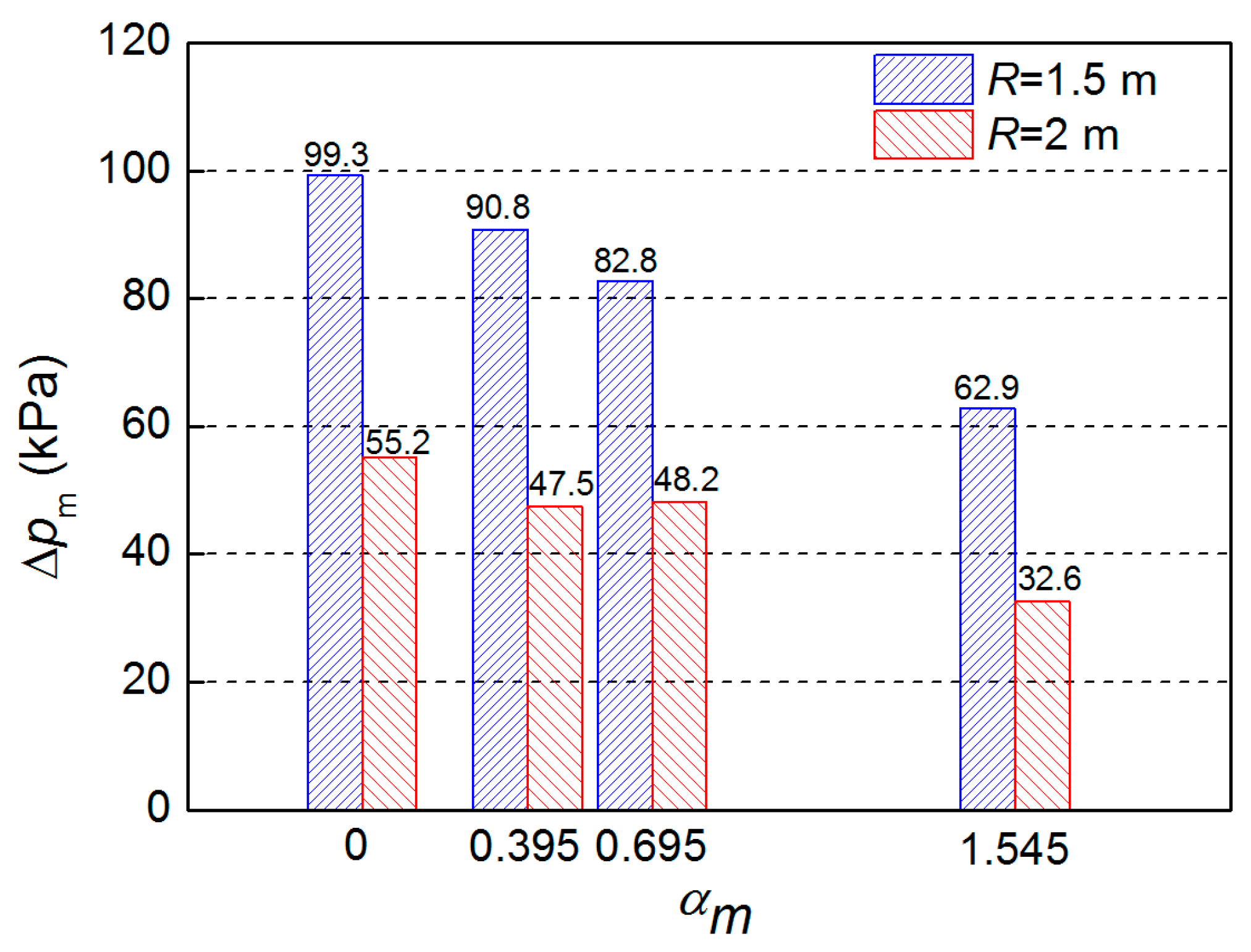

| No. | αm | px (MPa) | ux (m/s) | ck (m/s) |
|---|---|---|---|---|
| 001 | 0 | 87.5 | 7478 | 905 |
| 002 | 0.395 | 72.8 | 7036 | 1136 |
| 003 | 0.695 | 66.8 | 6740 | 1282 |
| 004 | 1.545 | 58.7 | 6321 | 1621 |
| Material | ρshell (g/cm3) | σ0.2 (MPa) | c0 (m/s) | λ |
|---|---|---|---|---|
| LiF/NR composite | 1.82 ± 0.02 | 2.945 | 2210 | 1.96 |
| Test No. | dshell (mm) | m0 (g) | mg (g) | αm |
|---|---|---|---|---|
| 001 | 0 | 65.42 | 0 | 0 |
| 002 | 3 | 65.39 | 25.83 | 0.395 |
| 003 | 5 | 65.42 | 45.47 | 0.695 |
| 004 | 10 | 65.40 | 101.04 | 1.545 |
| Sensor | Δpm (kPa) | χ | r2 |
|---|---|---|---|
| 1# | 82.21 | 1.549 | 0.944 |
| 2# | 83.45 | 1.930 | 0.928 |
| 3# | 48.75 | 0.725 | 0.983 |
| 4# | 47.66 | 0.402 | 0.981 |
| Test No. | 1.5 m | 2 m | ||||||||
|---|---|---|---|---|---|---|---|---|---|---|
| Exp. (kPa) | Theory (kPa) | Error (%) | Theory (kPa) | Error (%) | Exp. (kPa) | Theory (kPa) | Error (%) | Theory (kPa) | Error (%) | |
| 001 | 99.3 | 99 | 0.30 | 99 | 0.30 | 55.2 | 56.6 | −2.47 | 56.6 | −2.47 |
| 002 | 90.8 | 86.4 | 5.15 | 82.5 | 10.02 | 47.5 | 50.0 | −4.96 | 47.2 | 0.68 |
| 003 | 82.8 | 79.8 | 3.70 | 75.7 | 9.38 | 48.2 | 46.5 | 3.56 | 43.3 | 11.38 |
| 004 | 62.9 | 64.6 | −2.64 | 66.5 | −5.35 | 32.6 | 38.4 | −15.1 | 38.0 | −14.2 |
Disclaimer/Publisher’s Note: The statements, opinions and data contained in all publications are solely those of the individual author(s) and contributor(s) and not of MDPI and/or the editor(s). MDPI and/or the editor(s) disclaim responsibility for any injury to people or property resulting from any ideas, methods, instructions or products referred to in the content. |
© 2022 by the authors. Licensee MDPI, Basel, Switzerland. This article is an open access article distributed under the terms and conditions of the Creative Commons Attribution (CC BY) license (https://creativecommons.org/licenses/by/4.0/).
Share and Cite
Li, J.-B.; Li, W.-B.; Wang, X.-M.; Yu, J.-X. Prediction of Peak Overpressure of Charge Enveloped by Polymer Matrix Composite: Theoretical Modeling and Experimental Verification. Polymers 2023, 15, 219. https://doi.org/10.3390/polym15010219
Li J-B, Li W-B, Wang X-M, Yu J-X. Prediction of Peak Overpressure of Charge Enveloped by Polymer Matrix Composite: Theoretical Modeling and Experimental Verification. Polymers. 2023; 15(1):219. https://doi.org/10.3390/polym15010219
Chicago/Turabian StyleLi, Jun-Bao, Wei-Bing Li, Xiao-Ming Wang, and Jia-Xin Yu. 2023. "Prediction of Peak Overpressure of Charge Enveloped by Polymer Matrix Composite: Theoretical Modeling and Experimental Verification" Polymers 15, no. 1: 219. https://doi.org/10.3390/polym15010219
APA StyleLi, J.-B., Li, W.-B., Wang, X.-M., & Yu, J.-X. (2023). Prediction of Peak Overpressure of Charge Enveloped by Polymer Matrix Composite: Theoretical Modeling and Experimental Verification. Polymers, 15(1), 219. https://doi.org/10.3390/polym15010219






